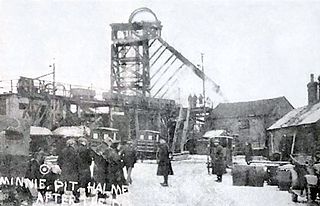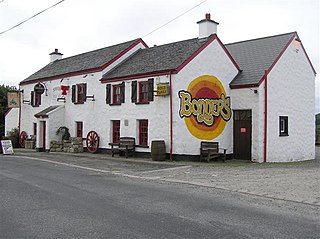
County Donegal is a county of Ireland in the province of Ulster and in the Northern and Western Region. It is named after the town of Donegal in the south of the county. It has also been known as County Tyrconnell or Tirconaill, after the historic territory. Donegal County Council is the local council and Lifford is the county town.

Unexploded ordnance and unexploded bombs (UXBs) are explosive weapons that did not explode when they were deployed and remain at detonative risk, sometimes many decades after they were used or discarded. When unwanted munitions are found, they are sometimes destroyed in controlled explosions, but accidental detonation of even very old explosives might also occur, sometimes with fatal consequences.

Clonmany is a village and civil parish in north-west Inishowen, in County Donegal, Ireland. The Urris valley to the west of Clonmany village was the last outpost of the Irish language in Inishowen. In the 19th century, the area was an important location for poitín distillation. Outside the village, there are a number of notable townlands, including Kinnea (Rockstown), Crossconnell, Dunaff, and Leenan.

Springhill mining disaster may refer to any of three deadly Canadian mining disasters that occurred in 1891, 1956, and 1958 in different mines within the Springhill coalfield, near the town of Springhill in Cumberland County, Nova Scotia. In the 1891 accident, 125 died; in 1956, 39 were killed; and in 1958, 75 miners were killed.
A mining accident is an accident that occurs during the process of mining minerals or metals. Thousands of miners die from mining accidents each year, especially from underground coal mining, although accidents also occur in hard rock mining. Coal mining is considered much more hazardous than hard rock mining due to flat-lying rock strata, generally incompetent rock, the presence of methane gas, and coal dust. Most of the deaths these days occur in developing countries, and rural parts of developed countries where safety measures are not practiced as fully. A mining disaster is an incident where there are five or more fatalities.

The RAF Fauld explosion was a military accident which occurred at 11:11 am on Monday, 27 November 1944 at the RAF Fauld underground munitions storage depot in Staffordshire, England. It was one of the largest non-nuclear explosions in history and the largest on UK soil.

The Glen of Imaal is a remote glen in the western Wicklow Mountains in Ireland. It is ringed by the Lugnaquilla massif and its foothills, including Table Mountain and Keadeen. Much of the valley is used by the Irish Army as an artillery firing range, and hill walkers who use the glen are advised to observe the times of firing practice and to refrain from picking up strange objects.
On June 9, 2006, an explosion on the beach near the Gaza Strip municipality of Beit Lahia killed eight Palestinians. At least thirty others were injured. The aftermath of the incident was captured on video and showed a distressed 11-year-old girl, Huda Ghaliya, reacting to the loss of family members, most of whom were killed in the incident. The footage of Ghaliya, which received considerable media attention, was broadcast on news networks around the world, making her a symbol of Palestinian suffering. The German newspaper Süddeutsche Zeitung questioned the reliability of the video footage.

The Coal Glen mine disaster was a series of explosions that occurred on May 27, 1925, at a coal mine in Coal Glen, Chatham County, North Carolina, United States. At least 53 miners died in the explosions, making it the deadliest industrial disaster in North Carolina's history. The incident also partly contributed to North Carolina's adoption of a workers' compensation law several years later.

Hpakant is a town in Hpakant Township, Kachin State in the northernmost part of Myanmar (Burma). It is located on the Uyu River 350 km north of Mandalay. It is famous for its jade mines which produce gem-quality jadeite.

The Minnie Pit disaster was a coal mining accident that took place on 12 January 1918 in Halmer End, Staffordshire, in which 155 men and boys died. The disaster, which was caused by an explosion due to firedamp, is the worst ever recorded in the North Staffordshire Coalfield. An official investigation never established what caused the ignition of flammable gases in the pit.
Albion Colliery was a coal mine in South Wales Valleys, located in the village of Cilfynydd, one mile north of Pontypridd.

Mullaghduff is a townland in northwest County Donegal, Ireland. It forms part of the greater Rosses region and is officially in the Gaeltacht, however, English is the predominantly spoken language today.

The Isle of Doagh is a small peninsula in the north of Inishowen on the north coast of County Donegal in Ulster, Ireland. It once was an island. Over time, the channel between Doagh and the mainland silted up and it became joined to the mainland. Nevertheless, the area continued to be referred as the Isle of Doagh or Doagh Island. The area comprises five townlands; Ballymacmoriarty, Carrickabraghy, Carrowreagh, Fegart and Lagacurry. Doagh Island is very near the village of Ballyliffin.
The Risca colliery disasters were a series of catastrophic mine explosions near the Welsh town of Risca in the nineteenth century. The most serious of these were in 1860 when more than 140 died in the Black Vein colliery and in 1880 when 120 died at the New Risca colliery.

Azerbaijan National Agency for Mine Action (ANAMA) is a mine action agency and executive body under State Commission for Reconstruction and Rehabilitation of War-Affected Areas of the Republic of Azerbaijan. The agency is accountable for implementing all necessary procedures corresponding to Azerbaijan Mine Action Program in order to decontaminate mines within the territory of Azerbaijan. Donors of the agency are government of Azerbaijan ($2,400,000) and UNDP ($160,000).

The Creeslough explosion occurred on 7 October 2022 at an apartment above Applegreen petrol station in Creeslough, a village in north County Donegal, Ireland. It killed ten people and left eight hospitalised; the highest number of civilian casualties in the county in decades. Investigators suspected an accidental gas leak.
Donegal explosion may refer to:














